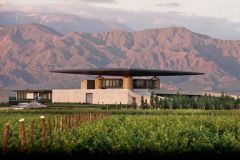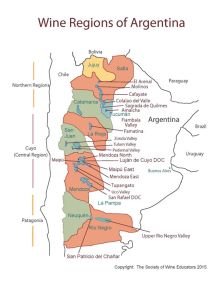While there is some wine production in the provinces of Buenos Aires, Cordoba, and La Pampa, the vast majority of wine production takes place in the far western expanse of Argentina leading up to the foothills of the Andes. The Mendoza region is the largest region and the leading producer, responsible for more than two-thirds of the country's yearly production, followed by the San Juan and La Rioja regions to the north.


Due to the high altitude and low humidity of the main wine producing regions, Argentine vinyards rarely face the problems of insects, fungi, molds and other grape diseases that affect vineyards in other countries. This allows cultivating with little or no pesticides, enabling even organic to be easily produced.
There are many different varieties of grapes cultivated in Argentina, reflecting her many immigrant groups. The French brought Malbec, which makes most of Argentina's best known wines. The Italians brought vines that they called Bonarda although Argentine Bonarda appears to be the Corbeau of Savoie also known as Charbono in California which may be related to Dolcetto.
While the historic birthplace of Malbec is Southwest France, it is in Argentina where the grape receives most of it notoriety. The grape clusters of Argentine Malbec are different from its French relatives; they have smaller berries in tighter, smaller clusters. Malbec wine is characterized by deep color and intense fruity flavors with a velvety texture. As of 2003 there were over 50,000 acres (20,000 hectares) of Malbec.
The Pedro Gimenez grape (a different but perhaps closely related relative of Spain's Pedro Ximenez) is the most widely planted white grape varietal with more than 36,300 acres (14,700 hectares) planted primarily in the Mendoza and San Juan region. The grape is known for its fully bodied wines with high alcohol levels and is also used to produce grape concentrate.
Argentina’s most highly rated Malbec wines originate from Mendoza’s high altitude wine regions of Lujan de Cuyo and the Uco Valley. These Districts are located in the foothills of the Andes mountains between 2,800 and 5,000 feet elevation.
Argentine vintner Nicolas Catena Zapata has been widely credited for elevating the status of Argentine Malbec and the Mendoza region through serious experimentation into the effects of high altitude. In 1994, he was the first to plant a Malbec vineyard at almost 5,000 feet elevation in the Gualtallary sub-district of Tupungato, the Adrianna Vineyard, and to develop a clonal selection of Argentine Malbec. High altitude Mendoza has attracted many notable foreign winemakers such as Paul Hobbs, Michel Rolland, Roberto Cipresso, and Alberto Antonini.(Source: Wikipedia, Food and Wine's Wine Guide, 2012)
Enjoy this 2014 student documentary on the Argentine wine industry.
